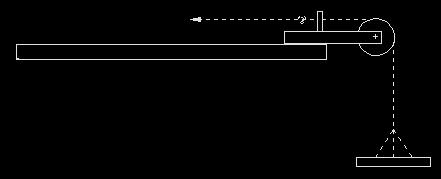The idea is very simple. The adjusted weight in the pan applies a force through the string to the loco coupler, which at the slippage point equals the drawbar pull. With the string wrapped around a known sized drum on a motor shaft, this can be used to measure stall torque.

The schematic above is dimensionless, since these will be determined by your scale and other factors. The size of the pulley is not critical, but it should have as little friction as possible.
The pan hanging at string end can be a plastic jar lid, large enough to hold the weights selected. It should be as light as possible and its weight should be adjusted to some known even weight unit for convenience. Three holes are drilled at 120 degrees apart for the support strings to secure balance.
The vertical string length from the pulley to the tie point of the support strings should be longer than the distance a loco can move to avoid jamming. The length of the pulley clevis should allow the pan to travel in free air. The height should position the horizontal string close to your coupler height.
A stop with a hole large enough and aligned to avoid horizontal string interference should be mounted above the clevis or on the track support. A knot or tied object, large enough not to pass through the hole should be positioned so as to prevent the pan from reaching the floor.
Weights can be purchased from hobby shops with science centers or cut from metal stock and trimmed to size. Units can be grams or ounces but should follow the 1-2-3-5-10-20-30-50 series in order to select any value. You may want 1/4 and 1/2 ounces for greater accuracy. Don't forget to add in the weight of the pan.
Weight is adjusted to the point where drivers just start to slip. The only major problem is in adjusting the the weight before you run out of track, necessitating several runs.
BACK TO MEASURING STARTING TRACTIVE EFFORT
